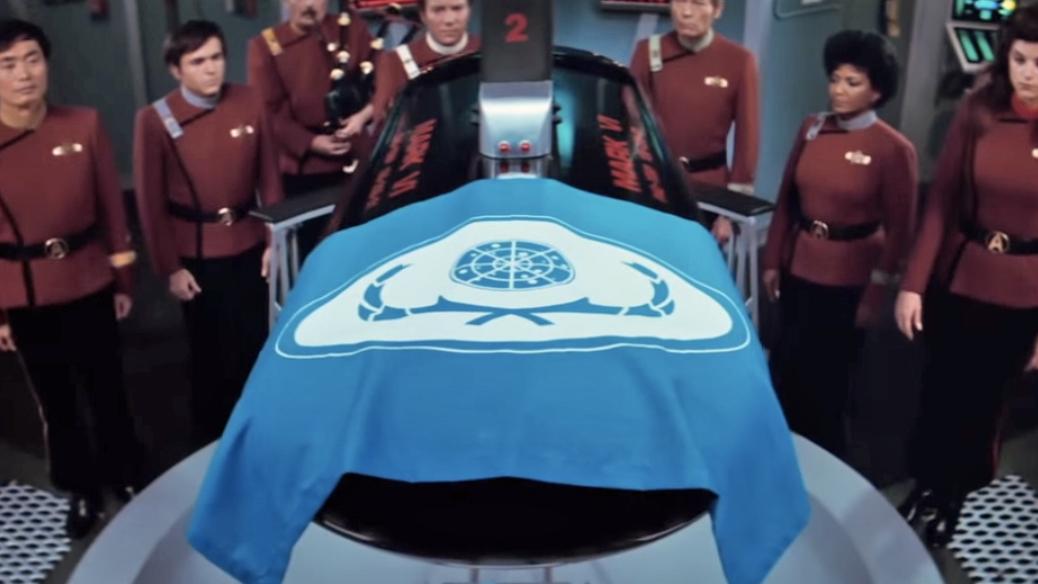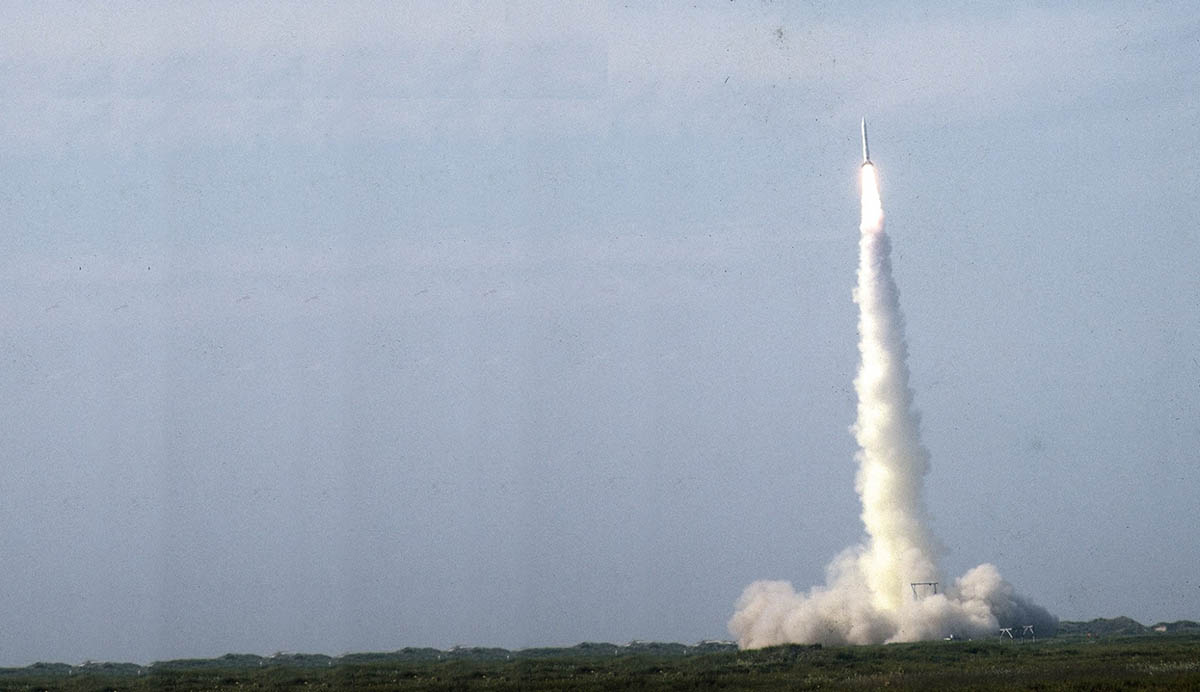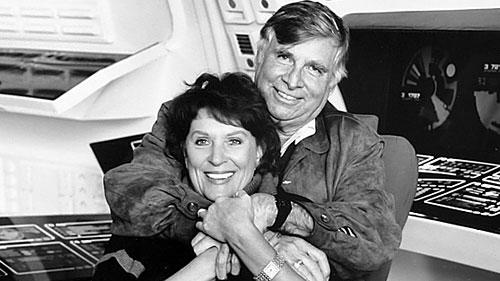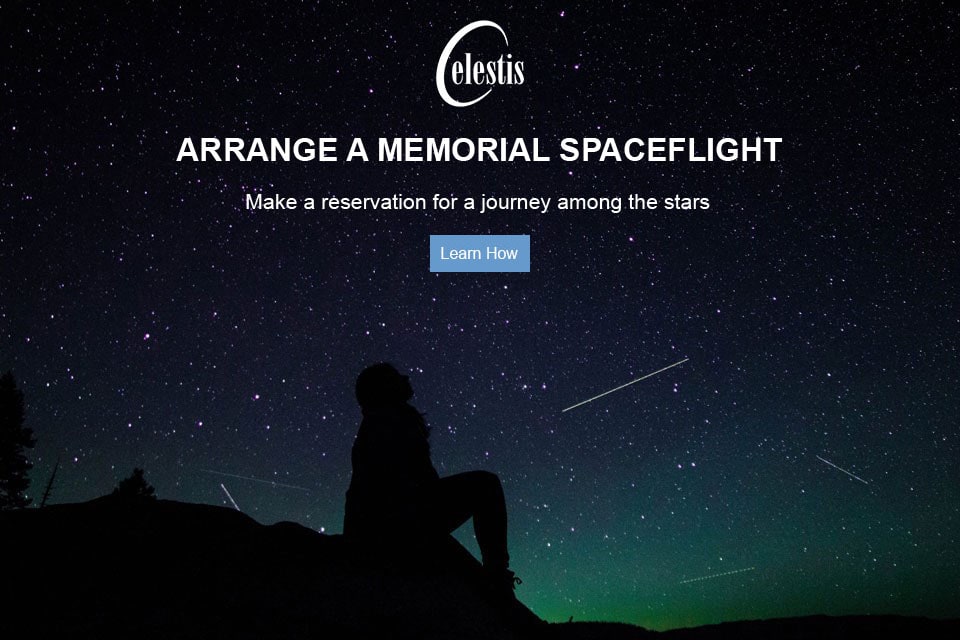On Earth, As in Space: Taking Our Terrestrial Rituals to Space

Spock's memorial service aboard the Enterprise in the 1982 movie Star Trek II: The Wrath of Khan. Image Credit: Paramount Pictures
by Emily Carney
The 1982 movie Star Trek II: The Wrath of Khan is not only arguably the most beloved and well-regarded Star Trek movie featuring the original series’ cast, but also provided a template for how humanity would bring its earthly rituals to outer space. In The Wrath of Khan, Spock, played by Leonard Nimoy, saved the Enterprise’s crew by restoring the ship’s warp drive. But his strategy came at a great cost – his own life.
A mortally irradiated Spock died in what may be perhaps the most emotional scene in franchise history. However, Spock isn’t buried at a graveside service on his home planet, or on any planet. The burial ritual takes place aboard the Enterprise, complete with a moving eulogy from the ship’s captain, James T. Kirk (played by William Shatner). At the end of the service, bagpipes play “Amazing Grace” as Spock’s casket is shot into the depths of space via a photon torpedo aimed at the Genesis Planet. The crew’s Doctor McCoy remarks at the end of the scene, which also ends the movie, “He's not really dead, as long as we remember him.” Symbolically, Spock became part of the Universe the Enterprise traversed as The Wrath of Khan drew to a close.
In 1982 the idea of having a “burial in space” seemed as wildly futuristic as Star Trek itself, but commercial spaceflight pioneers including retired Mercury astronaut Donald K. ‘Deke’ Slayton, entrepreneur David Hannah, Jr., and Charles Chafer of Space Services, Inc. of America were already thinking of making these traditionally Earthbound customs a reality. Following the successful launch of Conestoga 1, the first privately funded rocket launched into space, Slayton was greatly personally invested in the idea of memorial spaceflights. Rocket pioneer Krafft Ehricke’s burial wishes included a request to have his ashes carried into space. When Ehricke died in late 1984, Slayton was resolute in finding a way to have his wish fulfilled; a May 1985 letter from Slayton to Ehricke’s widow Ingeborg read, “[Former astronaut] Wally Schirra tells me that Mr. Ehricke wanted his ashes sent into space at an appropriate time. Since we are dealing with an organization who hopes to do that in the not too distant future, I thought I should at least make sure you were aware of that opportunity.”

On September 9, 1982 the commercial space age was inaugurated with the first launch of a privately funded rocket into space. The launch took place from a private launch facility on Matagorda Island, Texas. Image Credit: Celestis, Inc.
A previous Celestis blog post stated, “While a proposed mid-1980s memorial spaceflight ultimately didn't get off the ground, [Charles] Chafer later took it upon himself to see that Slayton's vision gained wings. ‘It was one of Deke's favorite [proposed] missions, and he always spoke highly of it, even after it didn't go. I would say that was part of the motivation I had to restart it ten years later was seeing his belief in it.’ ‘It’ being Celestis, Inc., formed in 1994.” By the mid-1990s, Chafer’s company Celestis was working to make these new, Space Age customs a reality – and was well on its way to fulfilling Ehricke’s dream.
Fast forward to 1997, and The Founders Flight, powered by an Orbital Sciences’ Pegasus XL launcher, rocketed into the history books as the first flight to serve as a private burial in space. The rocket carried the cremated remains of 24 intrepid “passengers,” including those of Star Trek creator Gene Roddenberry, space settlement pioneer Dr. Gerard K. O’Neill, Ehricke, and 1960s guru Timothy Leary.
Celestis has flown 16 more memorial spaceflights since, 17 missions in total. The most recent of those being its Horizon Flight, which was lofted into space during the SpaceX “Transporter-1” rideshare launch on January 24th, 2021. While the concept of memorial spaceflights aboard commercial spacecraft isn’t exactly new, to some the idea of a burial in space seems as foreign as the space world inhabited by the characters in Star Trek.
Contact us for more information or to receive launch updates
However, like Spock’s ceremony in The Wrath of Khan, as humanity navigates further into what O’Neill called “The High Frontier,” it’s only natural we will bring our terrestrial traditions to space. We’ve already seen some of these traditions take place, for example, aboard the International Space Station (ISS); the space station crews celebrate holidays such as Thanksgiving, Hanukkah, Christmas, and New Year aboard the orbiting scientific platform. Aboard this fall’s Inspiration4 mission, crew pilot Dr. Sian Proctor made art in space, painting aboard the Crew Dragon spacecraft; NASA astronaut Nicole Stott also painted in space during a long-duration ISS mission. So, it only makes sense that as humanity stretches further into the cosmos and learns to live for increasingly longer periods in space, we’ll also bring our end-of-life rituals with us.
A previous Celestis blog entitled “A Cultural Imperative” discussed how “lying at rest” in space will eventually become a routine part of the human experience:
The Celestis concept reaches deeply into the human experience – the earliest fictional literature postulating the possibility of humans leaving Earth included discussions of off planet funeral rituals and services. It is only natural that as we move throughout the solar system, we will take all of our celebrations and memorials with us – adapting and extending them to the unique circumstances of spaceflight and off Earth existence. As spaceflight turned from concept into reality, it was inevitable that Memorial Spaceflights would become an integral part of the space age.
Another example of an early space pioneer understanding this cultural imperative was William “Bill” Pogue, retired NASA astronaut and Skylab 4’s pilot. On June 25th, 2019, a portion of Pogue’s ashes were launched aboard Celestis’ Heritage Flight, which was rocketed into space by a SpaceX Falcon Heavy rocket from Kennedy Space Center’s Launch Complex 39A. A previous Celestis blog post underscored why Pogue chose this kind of send-off: “One of the early participants of the space age, Pogue understood possibly better than anyone else that the idea of ‘burial in space’ wasn’t just some crazy fantasy; as humanity further entered space, memorial spaceflights would make as much sense as, say, burial at sea, or having one’s ashes spread at a special place filled with good memories.”
*****
2022 marks the 25th anniversary of The Founders Flight, and also opens up a new frontier for Celestis as The Enterprise Flight, the company’s first flight to traverse the Earth-Moon system into deep space, launches during the summer. The Enterprise Flight not only has a very Star Trek-esque name, but also closes a circle for Celestis, as the company will have executed each of its mission profiles (Earth orbit missions, lunar missions, and deep space missions). The mission will carry ashes of several notable Star Trek figures, such as James Doohan (the original series’ Mr. Scott), and the series’ founder Roddenberry and his wife, Majel Barrett-Roddenberry.

Gene and Majel Barrett-Roddenberry, on a Star Trek set, will fly together on the first Celestis deep space mission, The Enterprise Flight. Image Credit: Celestis
In addition, Celestis will introduce a new “tradition” to its slate of services – the capability of creating a “living memorial,” and being able to “fly” in space with a beloved family member. Celestis DNA will allow those interested to fly their genetic material in space, with retrieval made easy and painless via a simple mouth swab. Reservations are still open for The Enterprise Flight, but they will close mid-April 2022 as Celestis readies itself for the flight.
In 1982, Star Trek may have introduced audiences to the then-novel idea of burial in space, but in 1997 – a short 14 years following the film’s premiere – Celestis transformed that idea into reality. Now, in 2022, 40 years after The Wrath of Khan, Celestis is preparing to introduce its own Enterprise: its expanded slate of services to deep space, reuniting its participants with the cosmos.
To paraphrase Dr. McCoy, “They’re never really gone, as long as we remember them.”




